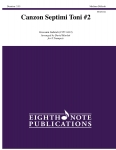It was a happy coincidence that the commission for SINFONIA XVI: TRANSCENDENTAL VIENNA came from the Henry David Thoreau School located in Vienna, Virginia.
Thoreau is one of the "magic" names in American culture: Henry David Thoreau, one of the leading figures of the Transcendentalist movement, centered in 19th-century New England, left us a body of unique philosophical and poetical writings. To utter the words, Walden Pond, is to invoke an America long past in physical actuality, but still present in the minds and hearts of many American citizens.
The name, Vienna, of course, summons thoughts of the Old World: culture, fine food, wine, civilized cities. While contemplating the form that SINFONIA XVI should take, I found myself thinking of two pillars of Viennese culture, expressionism, and the waltz.
Musically speaking, expressionism reached a zenith in the works of Arnold Schoenberg and Alban Berg. It was Berg, in particular, that I wanted to invoke in the outer movements of my composition. I knew I would also have to include a waltz, and an invocation of the mysterious forces that are contained in both expressionism and transcendentalism. Thus was the structure of the work generated.
The outer movements with their vision of the night sky and the stars, Aldebaran and Sirius, frame the central movements, which are essentially two versions of the same material, and are quieter and less dramatic. The outer movements are symmetrical, and share both pitch and rhythmic materials.
Accordingly, I see the work as a ternary form, with the central movements forming a unit within the outer "frame":
A (Movement 1)B (Movements 2 & 3)
A' (Movement 4)
Harmonically, the work can be summarized by the two pitch-series which occur in the opening bars of Movement 1: the initial 12-note row, with a tonal center on F-sharp (measures 1-6), and the subsequent D-minor Dorian 7-note row (beginning in measure 14). Aspects of these materials occur in all four movements, but they are most strongly present in Movements 1 and 4. Note that the 12-note row is not subjected to the usual serial procedures, but instead is treated as a signifier and is left unchanged.
Since the fourth movement takes up where the first movement leaves off, I can conceive of one interpretation of SINFONIA XVI as an evocation of Thoreau himself contemplating two of the brightest stars on a clear, cold night. Aldebaran is an orange, first-magnitude star, located in the constellation Taurus; Sirius, the Dog Star, is the brightest star in the sky, and is located in the constellation Canis Major. Thoreau interrupts his star-gazing to entertain some inward thoughts, waking dreams, as it were, then returns his gaze to the splendid night sky and all its treasures.
Although many other interpretations of the material are possible, it is important to remember that the abstract materials of the piece -- pitch, rhythm, structure -- are what count the most.



